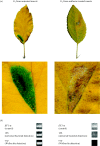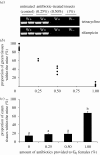Plant green-island phenotype induced by leaf-miners is mediated by bacterial symbionts
- PMID: 20356892
- PMCID: PMC2894905
- DOI: 10.1098/rspb.2010.0214
Plant green-island phenotype induced by leaf-miners is mediated by bacterial symbionts
Abstract
The life cycles of many organisms are constrained by the seasonality of resources. This is particularly true for leaf-mining herbivorous insects that use deciduous leaves to fuel growth and reproduction even beyond leaf fall. Our results suggest that an intimate association with bacterial endosymbionts might be their way of coping with nutritional constraints to ensure successful development in an otherwise senescent environment. We show that the phytophagous leaf-mining moth Phyllonorycter blancardella (Lepidoptera) relies on bacterial endosymbionts, most likely Wolbachia, to manipulate the physiology of its host plant resulting in the 'green-island' phenotype--photosynthetically active green patches in otherwise senescent leaves--and to increase its fitness. Curing leaf-miners of their symbiotic partner resulted in the absence of green-island formation on leaves, increased compensatory larval feeding and higher insect mortality. Our results suggest that bacteria impact green-island induction through manipulation of cytokinin levels. This is the first time, to our knowledge, that insect bacterial endosymbionts have been associated with plant physiology.
Figures



References
-
- Balibrea Lara M. E., Gonzalez Garcia M. C., Fatima T., Ehness R., Lee T. K., Proels R., Tanner W., Roitsch T.2004Extracellular invertase is an essential component of cytokinin-mediated delay of senescence. Plant Cell 16, 1276–1287 (doi:10.1105/tpc.018929) - DOI - PMC - PubMed
-
- Connor E. F., Taverner M. P.1997The evolution and adaptive significance of the leaf-mining habit. Oikos 79, 6–25 (doi:10.2307/3546085) - DOI
-
- Djemaï I., Meyhöfer R., Casas J.2000Geometrical games between a host and a parasitoid. Am. Nat. 156, 257–265 (doi:10.1086/303388) - DOI - PubMed
-
- Duron O., Bouchon D., Boutin S., Bellamy L., Zhou L., Engelstadter J., Hurst G. D.2008The diversity of reproductive parasites among arthropods: Wolbachia do not walk alone. BMC Biol. 6, 27 (doi:10.1186/1741-7007-6-27) - DOI - PMC - PubMed
-
- Elzen G. W.1983Cytokinins and insect galls. Comp. Biochem. Physiol. 76, 17–19 (doi:10.1016/0300-9629(83)90286-4) - DOI
Publication types
MeSH terms
Substances
Associated data
- Actions
- Actions
- Actions
- Actions
LinkOut - more resources
Full Text Sources
Molecular Biology Databases

